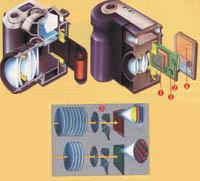The era of digital cameras
To see the differences between the two and the ways of working, we will rely on the following images. In cameras that have so far been common, light enters through the lens and causes a chemical change in the silver emulsion of the film inside. Then the film is taken from the camera and revealed photos are obtained.

However, digital cameras work very differently. The light entering the target hits the CCD (Charged Coupled Device). This electronic component (1) consists of thousands of photosensitive cells called photopoints that convert the light energy that each photopoint receives into an electric charge depending on its intensity. There is electrical and non-chemical change. Although in conventional cameras the appropriate sensitivity film can be placed on each occasion, in digital cameras the sensitivity of the CCD sensor is definitive (about 100 ISO or ASA).
Behind the CCD sensor is the ADC converter (Analóg Digital Converter) (2) whose mission is to convert the electrical charge corresponding to each photopoint of the figure into a binary number. Scanning corresponds to this ADC converter.
The DSP processor (Digital Signal Processor) then processes binary information (3) by interpolation, resulting in a higher number of final pixels. Mathematical algorithms calculate fiction pixels and add them in the most appropriate way to the original image. This allows you to overcome the limit of a certain amount of photopoints and recover the colored pixels. The image is then saved in the permanent memory, similar to the hard drive (4).
The light entering the camera is distributed in three basic colours (red, green and blue) (5). In the conventional camera the silver emulsion of the film has three sensitive layers, each of them sensitive to a color. However, the digital camera CCD capture is not able to differentiate colors from light rays and does not interpret color information. Therefore, most digital cameras have a red/green/blue filter before the CCD picker, where each color box corresponds to a photopoint. The pixel is the basic element to complete the digital image. Three different photopoints, each with their own color information, are necessary to form a pixel of colors.
The digital image, formed by these pixels, is stored in the memory located in the camera, sometimes in diskette. This has very important advantages, since this digital image can be used on the computer and on all its peripherals (printers, modems, etc. ). In addition on the computer you can view and treat the photos on screen, modify or exchange them using the appropriate computer program. You can send the photo online, record it on CD-Rom or print it on paper.
From the camera the photo pass cable is connected to the PC or Macintosh computer, but sometimes the data is also transmitted by infrared rays to the computer. Even on floppy disks, as mentioned above.
In digital cameras the zoom can be optical (as in conventional cameras) or digital, but it is only like a magnifying glass that increases the image when it is digital. On the back of the camera there is a small liquid glass screen to control the photo, as well as on camcopes. On this screen the user suddenly sees the photo taken and can also see the one stored in the memory. In addition, thanks to the buttons that the camera has, navigate through the menus to select the characteristics of the photo, classify the photos, delete them, etc., which is a great obstacle for some. For those who are used to using the computer it is easy, but there are many people who are not used to it and can have big headaches.
There are digital photo cameras that have no optical viewfinder and instead you have to use a small liquid crystal LCD screen to take pictures, but users quickly get used to stretching both arms and clicking on the back of the camera.
Features of digital cameras
Below are the characteristics that an ideal camera should have for those who are going to acquire a digital camera:
- CCD picker of at least 1,000,000 photopins.
- Long battery life with fast charging.
- Disconnectable LCD display and optical viewfinder.
- Minimum 3x optical zoom.
- Hard disk of at least 8 megas.
- Lens quality 28-115 mm of conventional 24x36 cameras and equivalent to f:2.
- Ability to record sound and animated image sequence.
- Possibility of taking a photographic sequence.
- Minimum 3 levels of registration quality.
- Integrated flash with different levels of use and additional flash jack.
Digital cameras that are currently on sale on the market do not have all the features of the previous list of the ideal camera, but those that are approaching are several. The approximate names and prices of some of them are:
- Kodak DC 260 (175,000 sts. or 6,990 pounds)
- Navica FD-81 Sony (150,000 pts. or 5,990 pounds)
- Nikon Coolpix 900 (210,000 sts. or 8,490 pounds)
- Minolta Dimage Ex (175,000 sts. or 6990 pounds)
In all of these cameras, the number of CCD picker photopoints conditions the image quality.
Published in 7K
Buletina
Bidali zure helbide elektronikoa eta jaso asteroko buletina zure sarrera-ontzian











